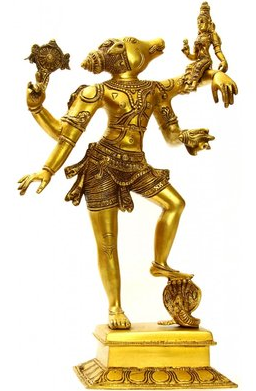Sri Lakshmi : a force of Nature
Here in India, we have just completed a week of celebrations in honour of Sri Lakshmi, the energy of manifestation and expansion, in Nature. But do we really understand who she represents? Do our practices of celebration do justice to her beauty and grace?
|
|
Worshipped in various forms Sri Lakshmi is primarily considered to be the goddess of prosperity and of abundance and most people translate this into money. However, this divine consort of Vishnu, the energy that maintains the Universe, is much more than a growing bank balance.
|
|
Hindu philosophy believes that the entire Natural world is created through the union of two forces, Shiva and Shakti. Shiva represents potential and Shakti, the force that bursts forth into manifestation. If Shiva is the DNA in a seed, Shakti is the energy that takes the intelligence of this DNA and brings forth an entire tree. Shiva and Shakti are also known as Purusha and Prakriti, even as Prakriti is another word that can be taken to mean Nature herself.
Sri Lakshmi is the form of Prakriti that we can see, the stunning beauty of natural forms, the gushing forth of streams and the magnificence of the morning sunlight... these are visible forms of Sri Lakshmi.
|
|
In one of her incarnations, Lakshmi took the form of Bhudevi another name for Prithvi, the Earth herself. The story of the ten incarnations , the Dasavatara says, when the earth was undergoing severe stress due to the wrong doings of those who were evil, Lord Vishnu took the form of Varaha - a boar and rescued her from the depths of the ocean where she had sunk.
Lakshmi as Bhudevi originated in the worship of the Earth as the Mother Goddess.
|
|
|
Lakshmi : the goddess of fertility and life
|
|
|
'Prithvi represented the female principle of fertility, and she was frequently praised by Vedic texts in this supportive capacity. She is the source of all vegetation, and thereby responsible for agricultural bounties. In her associations with such gifts, she was commonly symbolized as a cow. Hymns dedicated to Prithvi in the Vedas praise her for her sustaining fecudity as well as her incredible stability.'
( Source: http://www.newworldencyclopedia.org/entry/Bhudevi)
|
|
|
Lakshmi : the abundance of resources
|
|
|
Devdutt Pattanaik gives an interesting interpretation of Sri Lakshmi as the abundance of natural resources.
He says,
'To understand Lakshmi, we have to understand where wealth comes from. Wealth in its most primal form comes from under the ground. Plants come from under the ground. Minerals come from under the ground. Water comes from under the ground. Even petrol comes from under the ground. Lakshmi is therefore called Patala-nivasini, she who resides in the subterranean realm. The sea locks wealth, the subterranean realms lock wealth, trees lock wealth – until it is harnessed and released.'
Read more of his article here ...
http://devdutt.com/articles/indian-mythology/decoding-lakshmi.html
|
|
In all of these depictions of Sri Lakshmi, it may be noted that the the absence of Lakshmi is also cautioned as a very real possibility. Along with Lakshmi, comes her elder sister. Alakshmi, bringing strife and quarrels. This is the divisiveness that wealth can lead to.
At a deeper level, when Prakriti is disconnected from Purusha, it leads to Pralaya - crisis and ultimately dissolution. But then, Alakshmi is also worshiped in the form of Dhumavati.
'... if Nature is Kamala, Shree, Gauri, then Nature is also Mahamaari(plague or famine personified), Alakshmi and Dhumavati. After the dissolution, Pralaya of the world, only Nature, that is Prakriti exists. Devoid of mind, which is Purusha, the Goddess is said to exist as Dhumavati. Thus her widowhood is a metaphor for the Nature's separation from mind.'
(Source: https://www.quora.com/Who-is-Alakshmi)
In another story, Bhudevi gives birth to a son, Naraka who earns a name for his misdeeds. It is his elimination that is celebrated as Naraka Chaturdashi - on one of the days of the Diwali festival.
And extending the bovine symbolism, the vulnerability of the earth is depicted in her taking the form of a cow and seeking refuge from those who would exploit her.
Her departure leads to chaos and the legend of the samudra manthan, the churning of the ocean, indicates that this chaos was not unfamiliar to our ancestors. These days, we too are seeing more and more of Alakshmi in the way in which we disrespect and over exploit the planets natural abundance.
|
|
|
Lakshmi , Balance and Sustainability...
|
|
|
As the companion of Vishnu, the power of sustenance, Lakshmi may be considered the source of sustainability, when properly understood.
Lakshmi, for us then, is not about hoarding wealth but sharing it and Diwali an occasion to distribute - or re-distribute it. She is not so much about acquiring more and more, as she is about feeling full and content and feeling grateful. She is not just about enjoying beauty but about creating it as well.
Independent of human desire, Sri Lakshmi represents the balance of energies that sustain and nourish the Universe.
|

Vishnu as Varaha, balancing Lakshmi as Mother Earth. Source: https://www.exoticindiaart.com/sculptures/
|
|
|
In the rich and multilayered iconography of Hindu philosophy, is hidden the original wisdom, which understood and deeply respected our dependence on Nature. It is now imperative for us to return to that worldview and redevelop our inner connection to Nature and the Mother Goddess, Bhudevi Lakshmi.
|
|
|
|